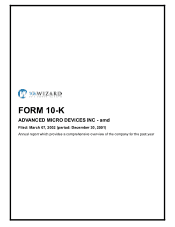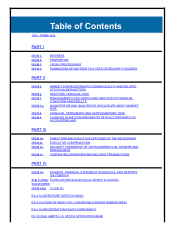AMD 2001 Annual Report Download - page 7
Download and view the complete annual report
Please find page 7 of the 2001 AMD annual report below. You can navigate through the pages in the report by either clicking on the pages listed below, or by using the keyword search tool below to find specific information within the annual report. The market for ICs can be divided into separate markets for digital and
analog devices. We participate in the market for digital ICs. The three types
of digital ICs used in most electronic systems are:
. microprocessors, which are used for control and computing tasks, and
complementary chipset devices;
. memory circuits, which are used to store data and programming
instructions; and
. logic circuits, which are employed to manage the interchange and
manipulation of digital signals.
A discussion of the principal areas of the digital IC market in which we
participate follows.
The Microprocessor Market
The microprocessor market consists of two broad categories, which are based
on the function of the products. A microprocessor that performs computing tasks
is known as the Central Processing Unit (CPU) of a computer system.
Microprocessors used for control applications are often referred to as embedded
processors. AMD participates primarily in the CPU category, which is the
largest category within the microprocessor market.
A CPU processor is an IC, generally consisting of millions of transistors,
that serves as the brain of a computer system such as a PC. The CPU processor
is typically the component most critical to the performance and efficiency of a
PC. The CPU processor controls data flowing through the electronic system and
manipulates data as specified by the hardware and software that controls the
system. In 1981, International Business Machines Corporation (IBM) introduced
its first PC containing a microprocessor based upon the x86 instruction set
developed by Intel Corporation and utilizing the Microsoft Corporation
MS-DOS(R) operating system. As circuit design and large scale integration
process technology have evolved, performance and functionality of each new
generation of x86 microprocessors have increased. The x86 microprocessor market
has been dominated by Intel since IBM's introduction of the PC.
The x86 microprocessor market is characterized by intense competition, short
product life cycles and rapid advances in product design and process
technology. Today, the greatest demand for microprocessors is from PC
manufacturers. With few exceptions, PC manufacturers require x86
microprocessors that are compatible with the Microsoft Windows(R) operating
system. Improvements in the performance characteristics of microprocessors and
decreases in production costs resulting from advances in process technology
have broadened the market for PCs and, as a result, increased the demand for
microprocessors.
The market for PC original equipment manufacturers (OEMs) is highly
competitive. Most PC suppliers have evolved from fully integrated manufacturers
with proprietary system designs to vendors focused on building brand
recognition and distribution capabilities. Almost all of these suppliers now
rely on Intel or on third-party manufacturers for the major subsystems of their
PCs, such as the motherboard and chipsets. These suppliers are also
increasingly outsourcing the design and manufacture of complete systems. The
third-party manufacturers of these subsystems, based primarily in Asia, are
focused on providing PCs, motherboards and complementary chipset devices that
incorporate the latest trends in features and performance at low prices.
Increasingly, these third-party manufacturers are also supplying fully
configured PC systems through alternative distribution channels.
Embedded processors are also an important part of the microprocessor market.
Embedded processors are general purpose devices used to carry out a single
application with limited user interface and programmability. A system designed
around an embedded processor usually cannot be programmed by an end user
because the system is preprogrammed to execute a specific task. Key markets for
embedded processors include telecommunications, networking, office automation,
storage, automotive applications and industrial control.
The Memory Market
Memory ICs store data and instructions and are characterized as either
volatile or non-volatile. Volatile devices lose their stored information after
electrical power is shut off while non-volatile devices retain their
3
Source: ADVANCED MICRO DEVIC, 10-K, March 07, 2002




















